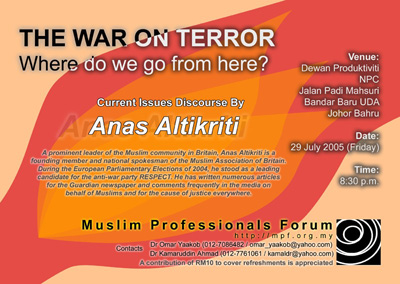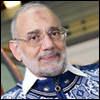Bandung 50 Years After
by Dr. Mazeni Alwi
The London terror bombings have consigned events of the last few weeks to distant memory. Headline – grabbing demonstrations in Edinburgh and the “Live 8” concerts that preceeded them today seem particularly very dated. Even more so, the celebrations to commemorate the 50th anniversary of the historic Bandung conference, with which the pop music concerts and the calls for the leaders of 8 wealthy nations to take concrete action share a common thread – third world poverty. Only a few among the young of today’s generation have probably heard of or cared about it, and those old enough to have a memory of it so disillusioned by its failures that they probably would rather prefer not to remember “the spirit of Bandung”.
Of my numerous trips to Indonesia over the years, my most recent one was as a guest of the Ikatan Dokter Anak Indonesia (Indonesian Paediatric Association) triennial convention in Bandung. This was only a few weeks after the celebrations of 50th anniversary of the Bandung Conference (which was held in April 1955). Gedung Merdeka, the venue of the original conference, a magnificent colonial era building is the heart of the city, was still dressed in celebratory mood, with banners and posters to remind visitors the historic event 50 years ago where Sukarno hosted leaders of newly independent nations of the 2 continents. Among them were also leaders of liberation movements of Algeria, Tunisia and Morocco, then in the midst of struggle for independence from French colonial rule to compare notes and take inspiration from the newly sovereign leaders. The atmosphere must have be electric, a gathering charismatic leaders who were then larger than life in the eyes of their people like Sukarno, Nasser and Hocine ait Ahmed (of Algeria’s FLN). Attempting to neutralize the air of radicalism, there was the pro American camp of leaders of Turkey, Ceylon, Pakistan and Iraq with their denunciations of Soviet colonialism, while Nehru stood as a symbol of relative moderation, having successfully avoided the excesses and violence of India’s independence process.
More than half of humanity was represented in Bandung in 1955 to proclaim the end of the colonial era and the emancipation of the coloured peoples in Asia and Africa. It was hailed as a new dawn for “the wretched of the earth”, whose goal was not just political independence, but ultimately economic, social and cultural liberation.
The new dawn was supposed to herald a new vision and strategy of freedom, solidarity and progress for the formerly colonized peoples, to take their destiny in their own hands after centuries of colonial oppression, exploitation and humiliation. Some sympathetic western intellectuals likened Bandung to humanity’s 1789 (the French Revolution). It was in relation to the historic event that the economist Affred Sauvy invented the term “third world” (tiers-monde), the peoples of Asia and Africa, who collectively hold immense material and human resources of the planet. Alas history has not been very kind to the denizens of the third world. For many, not much has changed 50 years post Bandung – remaining the wretched of the earth, and for some others, things have taken for the worse.
As for Bandung the city, those of us who know Indonesia through our experience of visiting Jakarta might be persuaded to think that she has lived up to the spirit of the conference she hosted half a century ago. She carries the burden of embodying its vision if Indonesia the nation cannot. The compact former hill station of the Dutch retains many of the beautiful colonial era buildings, notably the Governor’s residence, the Gedung Merdeka, a couple small churches and those used today as government and military offices. The pride of Bandung are her educational and scientific institutions, notably the Institut Teknologi Bandung and Universitas Padjajaran. But perhaps one institution that the conference hosts may want to pride themselves as their success in alleviating disease and poverty in the third world even if this is purely co-incidental is the Bio Farma, a biotechnology complex that manufactures vaccines and sera for Indonesia as well as supplying them to the third world in collaboration with the WHO. This is located in the “Pasteur” district of Bandung as Bio Farma was once called “Institut Pasteur”, next to the sprawling Hassan Sadikin Hospital complex, a teaching institution for the Universitas Padjajaran medical school. This former Dutch company was nationalized after Indonesia’s independence and now runs profitably as a state-owned company.
Unlike Jakarta, we do not see in Bandung the poor living in squalid squatter colonies and under flyovers, nor do we see children begging in the streets. The elegant old bungalows along her narrow, tree-lined streets are turned into commercial offices, or increasingly as factory-outlet stores of branded fashion goods- Bandung’s main attraction today. The new tolled highway has cut down traveling time from Jakarta to 2 ½ hours, such that hordes of the capital’s residents invade Bandung on weekends and during school holidays, making the traffic jams nearly as bad as that of the capital city. For this reason, I had to leave for the airport immediately after giving my lecture at the convention as it was held in the midst of school holidays in Indonesia. The driver deftly weaved through the congested traffic and the city’s back streets, having been told that I could not afford to miss the flight home as I had one to catch for Japan the next day.
Our familiarity with our neighbour with whom we share many things in common is such that one would not be easily deceived by Bandung’s air of new prosperity and old elegance, for Indonesia is another of those third world country that could not hide its extreme inequality, where there is an unbridgeable chasm between the rich and the poor. The two seemingly mingle but live in separate social universes outside the work place. When occasionally I get invited to help with some work in a private hospital, I would be chauffeured from the 5 star hotel to the hospital and have meals in Jakarta’s expensive restaurants, enabling me to catch a glimpse of how that section of society lives. Thankfully most of the time they’re institutional invitations where I get to see up close Indonesia’s poor and those who just manage to get by who are lucky enough to live near an urban centre.
In his opening address, the president of the Ikatan Dokter Anak read off startling statistics of the nation’s infant mortality rate and maternal deaths (during delivery), figures that would shock today’s public health experts in the developed world. And notwithstanding Bio Farma as Indonesia’s biotechnology showcase in the area of vaccine production, the nation recently saw outbreaks of polio among children that were highlighted in the international media.
Given what I do to earn a living, I can’t help using health indicators to illustrate the failures of nation building of a third world country like our neighbour, not out of condescension but as a sobering reminder for our own trajectory. For greater accuracy on this, one can always consult the UNDP reports. Its experience is by no means unique. Many of the new nations and those in the process of political liberation that were represented at the Bandung Conference had a disturbingly similar trajectory, particularly the Arab states. Political independence did not lead economic prosperity and social well-being for their citizens, self confidence and flowering of local culture. Instead, oppression and exploitation was continued by the new ruling elite, corruption became endemic, and poverty remains the lot of many.
Emanating from the grand ceremony of Bandung, the concept of the third world has however lost much of its moral weight in the last few decades. One of the more sympathetic figures of that generation that had expressed solidarity with the spirit of Bandung, the recently deceased Paul-Marie de la Gorce, gave a melancholic account 20 years ago, “Many hopes have been deceived, many illusions have vanished, many predictions proven false by history. The fashion today, even if seemingly excessive, is of disenchantment and skepticism : the third world would not have been able to resolve any of its problems – hunger, under development, disunity. The socialist experiments have turned into tropical dictatorships and the capitalist experiments into cosmopolitan corruption. No centres of power, no new international order could have been born from it. And it is remarkable that in France, Paul Bruckner’s Le Sanglot de l’homme blanc (Sobs of the white man) has had considerable success, a book full of bitterness and rancour, where all anticolonialism, every effort to understand the third world, our struggle against under development (on the part of western sympathizers) is seen as a sentiment of guilt, self-hate and masochism” (from “Bandung ou la fin de l’ère coloniale” by Jean Lacouture, Le Monde Diplomatique, April 2005, the quote taken from a 1984 issue of the same journal which I have translated here).
From Bandung to the invasion of Iraq, via the defeat of Nasserism, the sterile victory of Vietnam, the horrors of the Khmer Rouge and the Rwanda genocide, the third world has lost much of its moral capital. The Non-Aligned Movement, The G77, the South-South Commission – later incarnations of third world solidarity failed to gain respect and credibility as their meetings are nothing more than jamborees of corrupt dictators and semi-autocrats who have no respect for their own people.
Yes, there is the hypocrisy, unwillingness to relinquish its economic interests and sometimes naked desire for hegemonic control by some western powers, which means that the colonial masters never really left their colonies. We can blame these external forces as the cause of the continuing misery and poverty of ordinary people of the third world, but more than that, it is the leaders of the third world themselves on whom the responsibility rests. Long on rhetoric and short on ideas, not a few were autocratic, power crazed, corrupt and inept, readily accepting the role of proxies for the cold war warriors – even Sukarno, Nasser and the Algerian revolutionaries. They served as grave reminders of how power corrupts noble intentions and alienates those who wield it from their people if they don’t continually interrogate the whisperings of their egos.
Little wonder then that there was little to celebrate the 50th anniversary of Bandung. The new face of transnational terrorism born out of failed nation-building in the muslim world is perhaps the most potent symbol of its failure, and the raucous scenes of europeans begging on behalf of Africa’s poorest in Edinburgh or media flashes of young westerners of the “me” generation who think their pop music jamborees can end world poverty, its greatest humiliation. In this era of economic globalization whose currency is ruthlessness and greed, is a new vision possible to lift the world’s poor out of poverty and confer on them a human dignity long denied?
Dr. Mazeni Alwi


